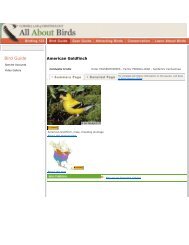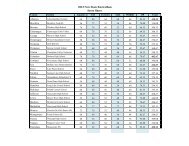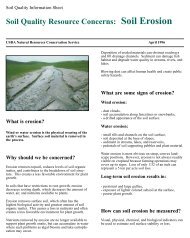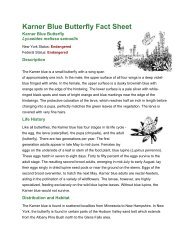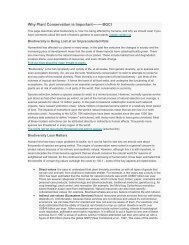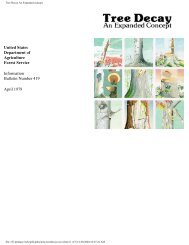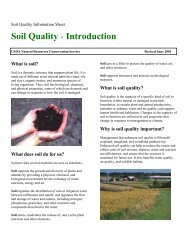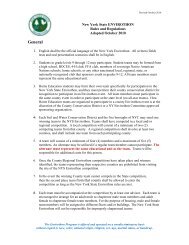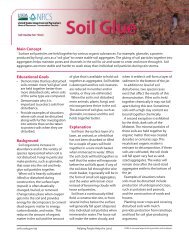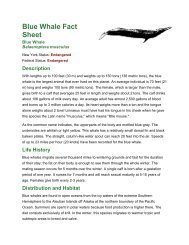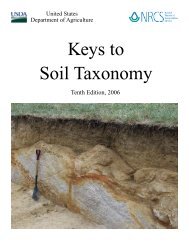Guidelines for Soil Quality Assessment in Conservation Planning
Guidelines for Soil Quality Assessment in Conservation Planning
Guidelines for Soil Quality Assessment in Conservation Planning
You also want an ePaper? Increase the reach of your titles
YUMPU automatically turns print PDFs into web optimized ePapers that Google loves.
WHAT IS SOIL QUALITY?<br />
<strong>Soil</strong> quality is the capacity of a specific<br />
k<strong>in</strong>d of soil to function with<strong>in</strong> natural or<br />
managed ecosystem boundaries to:<br />
• susta<strong>in</strong> plant and animal productivity<br />
• ma<strong>in</strong>ta<strong>in</strong> or enhance water and air<br />
quality<br />
• support human health and habitation<br />
<strong>Soil</strong> function describes what the soil<br />
does. <strong>Soil</strong> functions are: (1) susta<strong>in</strong><strong>in</strong>g<br />
biological activity, diversity, and<br />
productivity; (2) regulat<strong>in</strong>g and<br />
partition<strong>in</strong>g water and solute flow; (3)<br />
filter<strong>in</strong>g and buffer<strong>in</strong>g, degrad<strong>in</strong>g,<br />
immobiliz<strong>in</strong>g, and detoxify<strong>in</strong>g organic<br />
and <strong>in</strong>organic materials, <strong>in</strong>clud<strong>in</strong>g<br />
<strong>in</strong>dustrial and municipal by-products<br />
and atmospheric deposition; (4) stor<strong>in</strong>g<br />
and cycl<strong>in</strong>g nutrients and other elements<br />
with<strong>in</strong> the earth’s biosphere; and (5)<br />
provid<strong>in</strong>g support of socioeconomic<br />
structures and protection <strong>for</strong><br />
archeological treasures associated with<br />
human habitation. (Seybold et al, 1998).<br />
For the purposes of this guide, the terms<br />
soil quality, soil health, and soil<br />
condition are all <strong>in</strong>terchangeable.<br />
<strong>Soil</strong>s vary naturally <strong>in</strong> their capacity to<br />
function; there<strong>for</strong>e, quality is specific to<br />
each k<strong>in</strong>d of soil. This concept<br />
encompasses two dist<strong>in</strong>ct but<br />
<strong>in</strong>terconnected parts: <strong>in</strong>herent quality<br />
and dynamic quality.<br />
Characteristics, such as texture,<br />
m<strong>in</strong>eralogy, etc., are <strong>in</strong>nate soil<br />
properties determ<strong>in</strong>ed by the factors of<br />
soil <strong>for</strong>mation—climate, topography,<br />
vegetation, parent material, and time.<br />
Collectively, these properties determ<strong>in</strong>e<br />
the <strong>in</strong>herent quality of a soil. They help<br />
compare one soil to another and evaluate<br />
soils <strong>for</strong> specific uses. For example, all<br />
else be<strong>in</strong>g equal, a loamy soil will have a<br />
higher water hold<strong>in</strong>g capacity than a<br />
sandy soil; thus, the loamy soil has a<br />
higher <strong>in</strong>herent soil quality. This<br />
concept is generally referred to as soil<br />
capability. Map unit descriptions <strong>in</strong> soil<br />
survey reports are based on differences<br />
<strong>in</strong> the <strong>in</strong>herent properties of soils.<br />
More recently, soil quality has come to<br />
refer to the dynamic quality of soils,<br />
def<strong>in</strong>ed as the chang<strong>in</strong>g nature of soil<br />
properties result<strong>in</strong>g from human use and<br />
management. Some management<br />
practices, such as the use of cover crops,<br />
<strong>in</strong>crease organic matter and can have a<br />
positive effect on soil quality. Other<br />
management practices, such as till<strong>in</strong>g the<br />
soil when wet, adversely affect soil<br />
quality by <strong>in</strong>creas<strong>in</strong>g compaction.<br />
In this guide, soil quality refers to the<br />
dynamic quality of soil—those<br />
properties that are affected by<br />
management.<br />
What is <strong>Soil</strong> <strong>Quality</strong> and Why is it<br />
Important?<br />
• <strong>Soil</strong> quality refers to the dynamic<br />
quality of soil—those properties that<br />
are affected by management.<br />
• <strong>Soil</strong> quality evaluation is a tool to<br />
assess management-<strong>in</strong>duced changes<br />
<strong>in</strong> the soil and to l<strong>in</strong>k exist<strong>in</strong>g resource<br />
concerns to environmentally sound<br />
land management practices.<br />
<strong>Soil</strong> quality assessments are thus used to<br />
evaluate the effects of management on<br />
the health of the soil. The guidel<strong>in</strong>es <strong>in</strong><br />
this booklet provide <strong>in</strong><strong>for</strong>mation <strong>for</strong><br />
per<strong>for</strong>m<strong>in</strong>g the most typical soil quality<br />
assessments, which <strong>in</strong>clude:<br />
3



